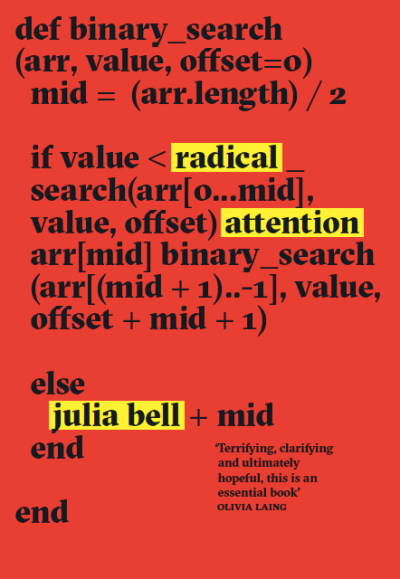You go out for a walk and leave your devices at home; your head feels a little bit clearer. But when you get back and plonk yourself in front of a screen, has anything really changed? Our unhealthy, deliberately engineered dependence on technology, together with the corresponding virtualisation of our bodies, form the crux of Julia Bell’s concise essay Radical Attention. But the book left me doubting whether there is any true escape from the “meatspace” of split minds.
Radical Attention gives us some poignant examples of the impact of technology – consequences we are probably aware of but have not quite admitted. You, too, have surely felt that “It never used to be like this when I sat down to write”, struggling to read a book without periodically checking your phone, or unable to focus on the television without simultaneously checking Twitter. “The broken screen has been cutting the tips of my fingers for weeks”, Bell writes of a smashed interface, referencing the splintering effect of social media on our attention spans. Ironically, when the system runs smoothly, we don’t even notice the damage it does.
Bell is also strong on the ways in which our bodies are virtualised and capitalised. She pares back the cladding over a world “where erotic and financial capital matters more than familial bonds”, recalling Michel Houellebecq’s fictions, in which disillusioned male characters lust after a virtualised image of women but fail miserably to inhabit a fulfilled bodily existence. Where dating is based on an “economy of looks”, incels “will always be undone by their lack of capital.” Bell joins in with Houellebecq’s critique of neoliberalism; in a world where you can theoretically choose anything you want, all you’re really choosing is what the algorithm tells you to choose. “Paying attention” is merely a transactional relationship in this virtual reality.
 The essay is delivered in aphoristic chunks, as if to mirror our limited capacity for engagement. But the sections thread together in oblique ways, requiring the kind of “radical attention” Bell advocates if we are really to get to grips with it. Might a strong narrative arc better catch our flighty brains? Yes, but this accumulative structure requires us to work harder to find the text’s creative meaning, already channelling our brains into new attentive grooves.
The essay is delivered in aphoristic chunks, as if to mirror our limited capacity for engagement. But the sections thread together in oblique ways, requiring the kind of “radical attention” Bell advocates if we are really to get to grips with it. Might a strong narrative arc better catch our flighty brains? Yes, but this accumulative structure requires us to work harder to find the text’s creative meaning, already channelling our brains into new attentive grooves.
In this vein, Bell’s essay moves to suggest how we can radicalise our attention. Her advice is “to start small, to pay attention to detail, and give your deliberate attention to what is in front of you”. Paraphrasing Simone Weil, she writes that “…attentive looking is, in and of itself, the point: an end in itself.” This alerts us to the fact that there is no way of completely mastering our attention. What we can do is train our brains, via the art of attentiveness, to “lapse” into creative thinking. We may start by leaving our phones behind: “Unencumbered by the screen I was actually able to be present with myself.” This is something we can all achieve, but do not often do – again, Bell has a talent for pointing out the obvious in fresh ways.
In the world of endless distractions that Bell so aptly describes, it is nigh on impossible to focus our minds. Bell points out that Headspace, the most popular mindfulness app, is valued at over $1 billion. She may as well add that it is a mere cog in the machine dividing our attention; using a Silicon-Valley-developed app to wean ourselves off attention-grabbing technology is only nullifying a problem for which deeper alleviation is required.
We still rely on the addictive cycles of social medial clickbait, and can’t live beyond them because much of life is governed by them. “Radical”, in the sense of thorough change, thus seems a misnomer for the graduality and individuality of any war against the machine. It comes down to whether small acts can be radical. Bell believes firmly that they can. But… buzz! I return from my walk sans screen, and a notification immediately pops up on my phone. There is little time to grab my attention at the root, to look “until the act of looking becomes boring, almost unbearable”. I’m back in the “meatspace”, and it’s like I was never away.















Add comment